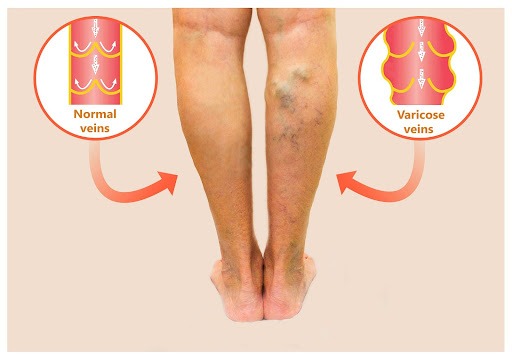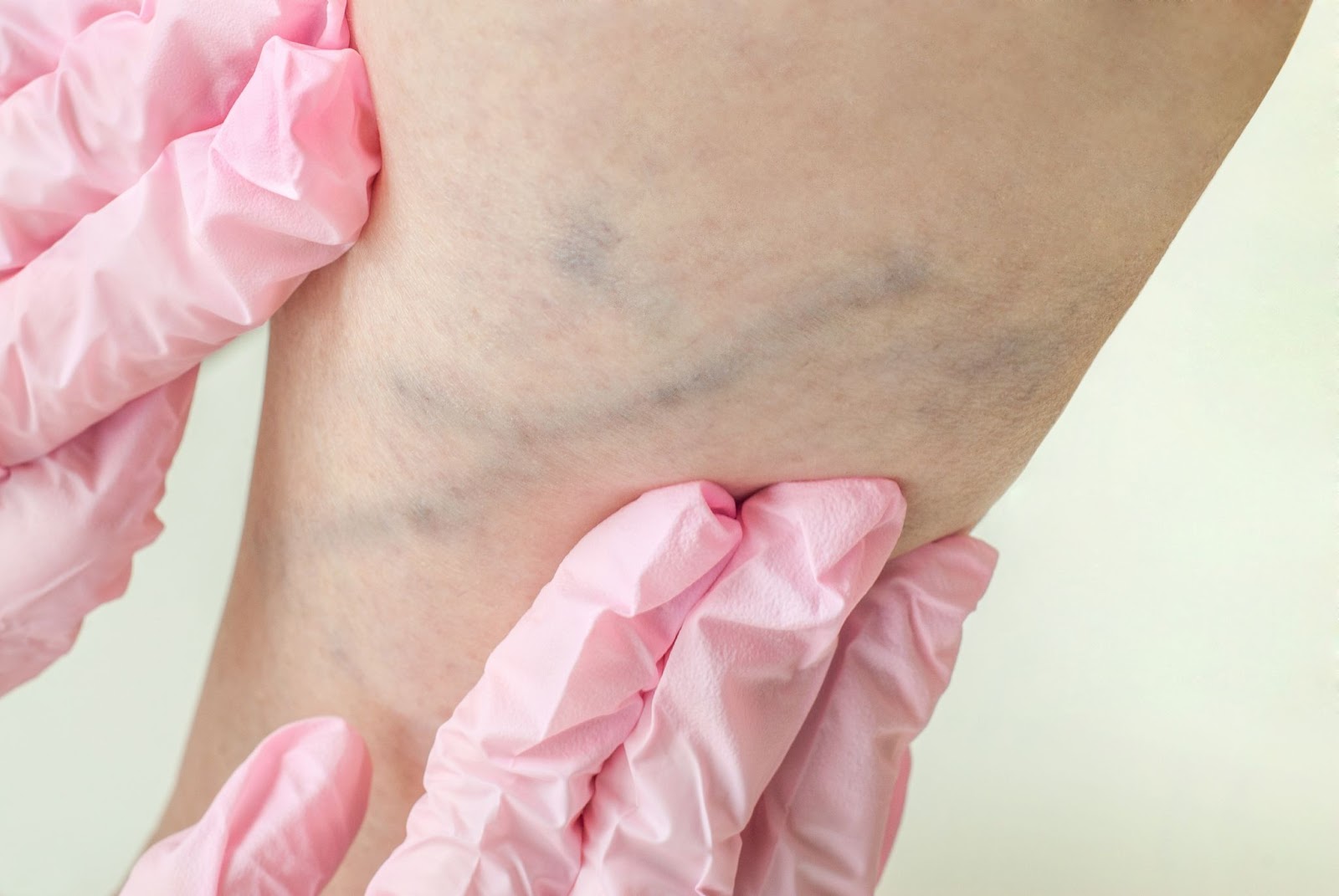Varicose Veins
A Route to Correct Treatment For Varicose Veins

by admin
26th September 2023
9 minutes read
Varicose veins are a common vascular condition that affects millions of people worldwide. These enlarged and twisted veins, usually found in the legs, can be more than just a cosmetic concern. They often lead to discomfort, pain, and other complications. Understanding the symptoms of varicose veins is essential for early diagnosis and proper treatment. In this blog, we will explore the various symptoms of varicose veins and how recognizing them can guide individuals toward the correct treatment, including laser treatment for varicose veins in Chennai, Kerala, Hyderabad, and other locations.
What are Varicose Veins?
Before delving into the symptoms, let’s briefly understand what varicose veins are and how they develop. Veins are blood vessels responsible for carrying deoxygenated blood back to the heart. They have one-way valves that prevent blood from flowing backward. When these valves weaken or fail, blood can pool in the veins, causing them to enlarge, twist, and become visible beneath the skin’s surface.
Factors such as age, family history, gender, pregnancy, obesity, and prolonged periods of standing or sitting can contribute to the development of varicose veins. While they can occur in any part of the body, they are most commonly found in the legs due to the increased pressure on the veins when standing upright.
Common Symptoms of Varicose Veins
Here are some common symptoms of varicose veins:
Visible Veins: The most apparent symptom of varicose veins is the appearance of enlarged, twisted, and swollen veins on the skin’s surface, usually in a dark blue or purple color.
Pain and Discomfort: Individuals with varicose veins may experience pain, throbbing, or aching sensations in the affected areas, often worsening after long periods of standing or sitting.
Leg Fatigue and Heaviness: Patients may report a feeling of heaviness or tiredness in their legs, particularly towards the end of the day.
Itching and Burning Sensation: Varicose veins can cause itching or a burning sensation around the affected veins.
Night Cramps: Some individuals may experience cramps in their legs, especially at night.
Swelling: Swelling or edema may occur in the lower legs due to fluid buildup caused by impaired blood flow.
Skin Changes: Over time, varicose veins can lead to skin changes, such as discoloration, dryness, and thickening or hardening of the skin in the affected area.
Ulcers: In severe cases, varicose veins can lead to skin ulcers, particularly near the ankles. These ulcers may be painful and slow to heal.
It’s important to note that not all individuals with varicose veins experience symptoms. Some people may have visible varicose veins without experiencing any discomfort, while others may have severe symptoms despite only having small spider veins.
Why Recognizing Symptoms Is Important?
Early diagnosis and treatment of varicose veins can prevent the condition from progressing and alleviate symptoms. If left untreated, varicose veins can lead to more serious complications, such as:
1. Superficial Thrombophlebitis:
Inflammation of a superficial vein, often accompanied by a blood clot. This condition can cause pain, redness, and swelling in the affected area.
2. Bleeding:
Varicose veins close to the skin’s surface may be more susceptible to injury, leading to bleeding.
3. Venous Ulcers:
Prolonged high pressure in varicose veins can cause skin ulcers, particularly near the ankles. These ulcers can be painful and may take a long time to heal.
4. Deep Vein Thrombosis (DVT):
In some cases, varicose veins may be associated with deep vein thrombosis, a condition where blood clots form in the deep veins, posing a risk of a life-threatening pulmonary embolism if the clot breaks free and travels to the lungs.
5. Chronic Venous Insufficiency (CVI):
If varicose veins are left untreated, they can lead to chronic venous insufficiency, a condition where the veins cannot adequately pump blood back to the heart, causing blood to pool in the legs.
Recognizing symptoms and seeking prompt medical evaluation can help prevent these complications and guide individuals toward the appropriate treatment.
Treatment Methods for Varicose Veins

The choice of treatment depends on the severity of the condition, the presence of symptoms, and the patient’s overall health. Below are some of the common treatment methods for varicose veins:
Conservative Treatments:
- Lifestyle Changes: Simple lifestyle modifications can help manage varicose veins. Regular exercise, maintaining a healthy weight, avoiding prolonged periods of standing or sitting, and elevating the legs can improve blood circulation and reduce symptoms.
- Compression Stockings: Wearing compression stockings applies pressure to the legs, helping to prevent blood from pooling in the veins and reducing swelling and discomfort.
Sclerotherapy:
- Sclerotherapy is a minimally invasive procedure in which a solution (sclerosant) is injected directly into the affected vein. The solution irritates the vein lining, causing it to collapse and seal shut. The body then gradually absorbs the closed vein, improving blood flow and reducing the appearance of varicose veins.
Endovenous Laser Ablation (EVLA):
- Endovenous laser ablation, also known as laser treatment for varicose veins, uses laser energy to close off the damaged vein. A thin laser fiber is inserted into the vein, and the laser heat causes the vein to collapse and seal shut. This procedure redirects blood flow to healthier veins, leading to symptom improvement and vein shrinkage.
Radiofrequency Ablation (RFA):
- Similar to EVLA, radiofrequency ablation uses heat generated by radiofrequency energy to close off the affected vein. The procedure is effective and minimally invasive, resulting in reduced pain and faster recovery compared to traditional surgical methods.
Ambulatory Phlebectomy:
- Ambulatory phlebectomy is a surgical procedure used to remove surface varicose veins through small incisions. This procedure is suitable for larger varicose veins that cannot be treated with sclerotherapy or endovenous techniques.
Laser and Intense Pulsed Light (IPL) Therapy for Spider Veins:
- For smaller spider veins and telangiectasia, laser therapy and intense pulsed light (IPL) therapy can be effective. These treatments use targeted light energy to heat and destroy the tiny veins, gradually fading their appearance.
Ligation and Stripping (Traditional Surgery):
- In more severe cases of varicose veins, traditional surgical methods such as ligation and stripping may be considered. Ligation involves tying off the affected vein to prevent blood flow, while stripping involves physically removing the vein. However, these procedures are now less common due to the availability of minimally invasive options like EVLA and RFA.
Endoscopic Vein Surgery:
- Endoscopic vein surgery is used for more severe cases of varicose veins with skin ulcers. An endoscope is inserted through a small incision to visualize and remove the affected vein.
It’s important to note that the choice of treatment depends on various factors, including the size and location of the varicose veins, the presence of symptoms, the patient’s medical history, and their preferences.
Laser Treatment for Varicose Veins
Laser treatment has become a popular option for addressing varicose veins, especially when conservative methods like lifestyle changes, compression stockings, and elevation of the legs do not provide sufficient relief.
Laser treatment for varicose veins involves the use of laser energy to target and close off the affected veins. During the procedure, a thin laser fiber is inserted into the damaged vein through a small incision. The laser emits heat, causing the vein to collapse and seal shut. Over time, the body naturally absorbs the closed vein, and blood is rerouted to healthier veins, improving circulation and reducing the appearance of varicose veins.
Some key benefits of laser treatment for varicose veins include:
1. Minimally Invasive:
Laser treatment is minimally invasive, requiring only a small incision, which reduces the risk of scarring and complications.
2. High Success Rate:
The procedure has shown significant success in treating varicose veins, with many patients experiencing long-lasting results.
3. Quick Recovery:
Compared to traditional vein-stripping surgery, the recovery time for laser treatment is much shorter, allowing patients to return to their regular activities sooner.
4. Local Anesthesia:
Laser treatment can be performed under local anesthesia, which is generally safer than general anesthesia.
5. Outpatient Procedure:
Most laser treatments for varicose veins are performed on an outpatient basis, reducing hospitalization and associated costs.
Conclusion
Varicose veins are a common vascular condition that can lead to discomfort, pain, and other complications. Recognizing the symptoms of varicose veins is crucial for early diagnosis and appropriate treatment. If you experience visible veins, pain, discomfort, leg fatigue, or any other symptoms associated with varicose veins, it’s essential to consult a qualified specialist for evaluation and personalized treatment options.
Laser treatment for varicose veins in Chennai, Kerala, Hyderabad, and other locations offers an effective and minimally invasive option for managing varicose veins. However, each individual is unique, and the most suitable treatment plan will depend on various factors, including the severity of the condition and the patient’s overall health.
Remember, varicose veins are not just a cosmetic concern; they can have a significant impact on your well-being and quality of life. Taking proactive steps towards recognizing the symptoms and seeking appropriate treatment can help you find relief and regain confidence in your legs’ health.
How Can Medfin Help?
Medfin is a daycare surgery expert providing access to the latest surgical procedures and top doctors in your city at affordable prices. Medfin provides you access to top doctors and surgeons with 10+ years of experience . With Medfin, you can leave your hassles behind and focus on your health. From instant consultations to paperwork assistance, we have got you covered with everything. So why wait? Call us today!
FAQs
1. What are the treatment options for varicose veins?
Treatment options include minimally invasive procedures like endovenous laser treatment (EVLT), radiofrequency ablation (RFA), and sclerotherapy. Surgical procedures like vein ligation and stripping are less common due to advancements in minimally invasive techniques.
2. Is varicose veins treatment covered by insurance?
Insurance coverage varies based on the severity of your condition and your insurance provider. Some treatments for symptomatic varicose veins may be covered if deemed medically necessary.
3. What is the recovery like after varicose veins treatment?
Minimally invasive treatments often involve minimal downtime. You may be advised to wear compression stockings and avoid vigorous activities for a short period. Your doctor will provide post-treatment instructions tailored to your specific procedure.
CATEGORIES
- ACL Reconstruction
- Anal Fissures
- Anal Fistula
- Appendicitis
- ASK A DOCTOR
- Benign Prostatic Hyperplasia
- Breast Lump Excision
- Cataract
- Circumcision
- Conditions & Diseases
- Cosmetology
- Covid-19
- Cure
- Endocrinology
- ENGLISH VIDEOS
- Eye Care
- Gallstones
- General Surgeries
- Government Schemes
- Gynaecology
- Gynecomastia
- Gynecomastia
- Health
- Health Insurance
- Hernia
- hindi
- Hip Arthoscopy
- Hip Replacement
- Hip Replacement Surgery
- Hydrocele
- Kannada
- Kidney Stones
- Knee Arthroscopic
- Laparoscopic
- LASER
- Latest Treatments
- Lifestyle
- Liposuction
- Medfin Stories
- Medicine
- Nephrology
- Ophthalmology
- Orthopaedic
- Paraphimosis
- Patient Testimonials
- PCL Reconstruction
- Phimosis
- Piles (Hemorrhoids)
- Pilonidal Sinus
- Proctology
- Prostate Artery Embolization
- Rhinoplasty
- Second Opinion
- Total Knee Replacement
- Uncategorised
- Urology
- uterine artery embolization
- Uterine Fibroids
- Varicocele
- Varicose Veins
- Vascular
- VIDEOS






